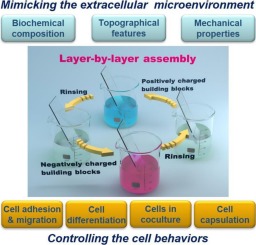Progress in Polymer Science ( IF 27.1 ) Pub Date : 2019-02-16 , DOI: 10.1016/j.progpolymsci.2019.02.004 Ke-feng Ren , Mi Hu , He Zhang , Bo-chao Li , Wen-xi Lei , Jia-yan Chen , Hao Chang , Li-mei Wang , Jian Ji

|
Cellular behavior is crucially dependent on the biophysical and biochemical properties of the extracellular matrix (ECM), in which the properties of biochemistry, topography, and mechanics are critically important and dominantly studied. Since its introduction by Decher and Lvov in the early 1990s, layer-by-layer (LbL) assembly technology has received considerable interest for constructing polymeric thin films in both academic and industrial studies. The technology has been especially important in applications involving biomedical materials, tissue engineering, and regenerative medicine. In recent years, because of outstanding flexibility and multipotency, polymeric LbL thin films have been extensively studied to create a biomimetic cellular microenvironment with one or more biophysical and biochemical properties. The field has moved from simple mimicking to active control of various cellular behaviors. This review first introduces the basic background of the natural cellular microenvironment, the LbL assembly, and progress in polymeric LbL thin films. Next, biomimetic films constructed using the LbL technique are introduced. The biochemical components, topographical features, and mechanical properties of the films are detailed. Furthermore, progress in thin LbL films for controlling cell behavior, such as cell adhesion, stem cell differentiation, and cell-cell interactions, are highlighted. Finally, the review closes with a summary and a brief outlook of the opportunities and challenges associated with polymeric LbL thin films for advancing promising future developments.
中文翻译:

逐层组装是构建细胞外基质模拟表面以调节细胞行为的可靠方法
细胞行为关键取决于细胞外基质(ECM)的生物物理和生化特性,其中生化特性,形貌和力学特性至关重要,并且需要进行大量研究。自1990年代初Decher和Lvov引入层到层(LbL)组装技术以来,学术和工业研究都对构建聚合物薄膜产生了浓厚的兴趣。该技术在涉及生物医学材料,组织工程和再生医学的应用中尤其重要。近年来,由于出色的柔韧性和多功能性,对聚合物LbL薄膜进行了广泛的研究,以创建具有一种或多种生物物理和生化特性的仿生细胞微环境。该领域已经从简单的模仿变成了对各种细胞行为的主动控制。这篇综述首先介绍了天然细胞微环境的基本背景,LbL组装以及聚合LbL薄膜的研究进展。接下来,介绍使用LbL技术构建的仿生膜。详细介绍了薄膜的生化成分,形貌特征和机械性能。此外,突出了用于控制细胞行为,例如细胞粘附,干细胞分化和细胞间相互作用的LbL薄膜的进展。最后,总结总结了聚合物LbL薄膜在推动有前途的未来发展方面的机遇和挑战,并进行了总结和简要展望。这篇综述首先介绍了天然细胞微环境的基本背景,LbL组装以及聚合LbL薄膜的研究进展。接下来,介绍使用LbL技术构建的仿生膜。详细介绍了薄膜的生化成分,形貌特征和机械性能。此外,突出了用于控制细胞行为,例如细胞粘附,干细胞分化和细胞间相互作用的LbL薄膜的进展。最后,总结总结了聚合物LbL薄膜在推动有前途的未来发展方面的机遇和挑战,并进行了总结和简要展望。这篇综述首先介绍了天然细胞微环境的基本背景,LbL组装以及聚合LbL薄膜的研究进展。接下来,介绍使用LbL技术构建的仿生膜。详细介绍了薄膜的生化成分,形貌特征和机械性能。此外,突出了用于控制细胞行为,例如细胞粘附,干细胞分化和细胞间相互作用的LbL薄膜的进展。最后,总结总结了聚合物LbL薄膜在推动有前途的未来发展方面的机遇和挑战,并进行了总结和简要展望。介绍了使用LbL技术构建的仿生膜。详细介绍了薄膜的生化成分,形貌特征和机械性能。此外,突出了用于控制细胞行为,例如细胞粘附,干细胞分化和细胞间相互作用的LbL薄膜的进展。最后,总结总结了聚合物LbL薄膜在推动有前途的未来发展方面的机遇和挑战,并进行了总结和简要展望。介绍了使用LbL技术构建的仿生膜。详细介绍了薄膜的生化成分,形貌特征和机械性能。此外,突出了用于控制细胞行为,例如细胞粘附,干细胞分化和细胞间相互作用的LbL薄膜的进展。最后,总结总结了聚合物LbL薄膜在推动有前途的未来发展方面的机遇和挑战,并进行了总结和简要展望。



























 京公网安备 11010802027423号
京公网安备 11010802027423号